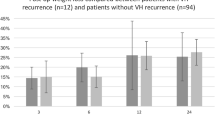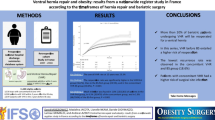Abstract
Background
Obesity predisposes patients to abdominal wall hernias. Patients undergoing bariatric surgery are not uncommonly found to have ventral hernias. Synchronous ventral hernia repair (S-VHR) has been reported in 2–5 % of patients undergoing bariatric surgery. Studies reporting on the outcomes of S-VHR are limited by sample size. The aim of this study was to assess the effect of S-VHR on surgical site infection (SSI) rate.
Methods
The American College of Surgeons National Surgical Quality Improvement Program (ACS-NSQIP) database from 2010 to 2011 was queried using Current Procedural Terminology codes for bariatric surgery. Data on patient demographics, comorbidities, procedural events, and postoperative occurrences were analyzed. Thirty-day mortality and morbidity were assessed. Comparisons between laparoscopic Roux-en-Y gastric bypass (RYGB) and sleeve gastrectomy (SG) were performed.
Results
We identified 17,117 patients who underwent RYGB or SG. S-VHR was performed in 503 (2.94 %) patients. S-VHR was independently associated with SSI (odds ratios (OR) 1.65, 95 % confidence interval (CI) 1.06–2.58), but not overall morbidity (OR 1.33, 95 % CI 0.96–1.86). Four hundred thirty-three patients with RYGB and 70 with SG had S-VHR. Serious morbidity (3.5 vs. 5.7 %, p = 0.32) and overall morbidity (8.3 vs. 8.6 %, p = 0.942) were similar. After controlling for baseline comorbidities, there was no significant effect of procedure type on SSI (OR 0.38, 95 % CI 0.05–2.91).
Conclusions
S-VHR is associated with an increase in SSI but not overall morbidity. There is no significant difference in the SSI rate between RYGB and SG. Larger studies are needed to definitively assess a potential difference in the wound infection rate between RYGB and SG.
Similar content being viewed by others
References
Livingston EH. The incidence of bariatric surgery has plateaued in the U.S. Am J Surg. 2010;200(3):378–85.
Pories WJ, Swanson MS, MacDonald KG, et al. Who would have thought it? An operation proves to be the most effective therapy for adult-onset diabetes mellitus. Ann Surg. 1995;222(3):339–52.
Schauer PR, Kashyap SR, Wolski K, et al. Bariatric surgery versus intensive medical therapy in obese patients with diabetes. N Engl J Med. 2012;366:1567–76.
Buchwald H, Avidor Y, Braunwald E, et al. Bariatric surgery a systematic review and meta-analysis. J A Med Assoc. 2004;292(14):1724–37.
Lau B, Kim H, Haigh PI, et al. Obesity increases the odds of acquiring and incarcerating noninguinal abdominal wall hernias. Am Surg. 2012;78(10):1118–21.
Raj PP, Senthilnathan P, Kumaravel R, et al. Concomitant laparoscopic ventral hernia mesh repair and bariatric surgery: a retrospective study from a tertiary care center. Obes Surg. 2012;22:685–9.
Datta T, Eid G, Nahmias N, et al. Management of ventral hernias during laparoscopic gastric bypass. Surg Obes Relat Dis. 2008;4:754–8.
Eid GM, Wikiel KJ, Entabi F, et al. Ventral hernias in morbidly obese patients: a suggested algorithm for operative repair. Obes Surg. 2013;23:703–9.
Carbonell AM, Criss CN, Cobb WS, et al. Outcomes of synthetic mesh in contaminated ventral hernia repairs. J Am Coll Surg. 2013;217:991–8.
Choi JJ, Palaniappa NC, Dallas KB, et al. Use of mesh during ventral hernia repair in clean-contaminated and contaminated cases. Ann Surg. 2012;255:176–80.
Cozacov Y, Szomstein S, Safdie FM, et al. Is the use of prosthetic mesh recommended in severely obese patients undergoing concomitant abdominal wall hernia repair and sleeve gastrectomy? J Am Coll Surg. 2014;218:358–62.
Spaniolas K, Trus TL, Adrales GL, et al. Early morbidity and mortality of laparoscopic sleeve gastrectomy and gastric bypass in the elderly: a NSQIP Analysis. Surg Obes Relat Dis. 2014;10(4):584–8.
Spaniolas K, Trus TL, Adrales GL. Ventral hernia repairs in the oldest-old: high-risk regardless of approach. Surg Endosc. 2014;28(4):1230–7.
Raziel A, Sakran N, Szold A, et al. Concomitant bariatric and ventral/incisional hernia surgery in morbidly obese patients. Surg Endosc. 2014;28(4):1209–12.
Bonatti H, Hoeller E, Kirchmayr W, et al. Ventral hernia repair in bariatric surgery. Obes Surg. 2004;14:655–8.
Raftopoulos I, Courcoulas AP. Outcome of laparoscopic ventral hernia repair in morbidly obese patients with a body mass index exceeding 35 kg/m2. Surg Endosc. 2007;21:2293–7.
Eid GM, Mattar SG, Hamad G, et al. Repair of ventral hernias in morbidly obese patients undergoing laparoscopic gastric bypass should not be deferred. Surg Endosc. 2004;18(2):207–10.
Schuster R, Curet MJ, Alami RS, et al. Concurrent gastric bypass and repair of anterior abdominal wall hernias. Obes Surg. 2006;16:1205–8.
Chan DL, Talbot ML, Chen Z, et al. Simultaneous ventral hernia repair in bariatric surgery. ANZ J Surg. 2014;84(7–8):581–3.
Acknowledgments
Since this study was performed using de-identified nationwide data, informed consent was not obtained for the purposes of this research.
All procedures performed in studies involving human participants were in accordance with the ethical standards of the institutional and/or national research committee and with the 1964 Helsinki declaration and its later amendments or comparable ethical standards.
Conflict of Interest
Konstantinos Spaniolas, Keven R. Kasten, Anthony B. Mozer, Megan E. Sippey, William H.H. Chapman, Walter J. Pories, and John R. Pender IV have no conflict of interest to declare. The authors report no grant support or additional acknowledgments.
Author information
Authors and Affiliations
Corresponding author
Rights and permissions
About this article
Cite this article
Spaniolas, K., Kasten, K.R., Mozer, A.B. et al. Synchronous Ventral Hernia Repair in Patients Undergoing Bariatric Surgery. OBES SURG 25, 1864–1868 (2015). https://doi.org/10.1007/s11695-015-1625-7
Published:
Issue Date:
DOI: https://doi.org/10.1007/s11695-015-1625-7




